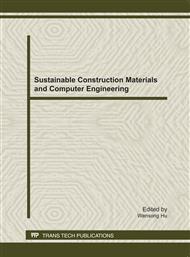[1]
H. Huynh, D. Raghavan: Durability of simulated shredded rubber tire in highly alkaline environments, Advn. Cem. Bas. Mat. (1997), pp.138-143.
DOI: 10.1016/s1065-7355(97)90021-3
Google Scholar
[2]
F. Hernandez-Olivares, Balunga: Static and dynamic behaviour of recycled tire rubber-filled concrete, Cement and Concrete Research, Vol. 32 ( 2002), p.1587–1596.
DOI: 10.1016/s0008-8846(02)00833-5
Google Scholar
[3]
H. A. Toutanji: The use of rubber tire particles in concrete to replace mineral aggregates. cement and concrete composites, ( 1996), pp.135-139.
DOI: 10.1016/0958-9465(95)00010-0
Google Scholar
[4]
N. Sergo, I. Joekes: Use of rubber particles as addition to cement paste. Cement and Concrete Research, Vol. 30 (2000), pp.1421-1425.
DOI: 10.1016/s0008-8846(00)00373-2
Google Scholar
[5]
R. Siddique, J. Khatib, I. Kaur: Use of recycled plastic in concrete: A review. Waste Management, Vol. 28 (2008), p.1835–1852. .
DOI: 10.1016/j.wasman.2007.09.011
Google Scholar
[6]
D. Garcı´a a, J. Lo´pez a, R. Balart a, R.A. Ruseckaite b, P.M. Stefan: Composites based on sintering silica fume–waste tire rubber mixtures, Materials and Design, Vol. 28 (2007), p.2234–2238.
DOI: 10.1016/j.matdes.2006.06.001
Google Scholar
[7]
M. Batayneh, I. Marie, I. Asi: Use of selected waste materials in concrete mixes, Waste Management, Vol. 27 (2007), 1870–1876.
DOI: 10.1016/j.wasman.2006.07.026
Google Scholar
[8]
M. C. Bignozzi, F. Sandrolini: Tire rubber waste recycling in self-compacting concrete. Cement and Concrete Research, Vol. 36 (2006), 735–739.
DOI: 10.1016/j.cemconres.2005.12.011
Google Scholar
[9]
K. Malek , A. Batayneh , I. Marie, I. Asi: Promoting the use of crumb rubber concrete in developing countries, Waste Management, Vol. 28 (2008), p.2171–2176.
DOI: 10.1016/j.wasman.2007.09.035
Google Scholar
[10]
D. Garcia, J. Lopez: Composites based on sintering silica fume–waste tire rubber mixtures . Materials and Design, Vol. 28 (2007), p.2234–2238.
DOI: 10.1016/j.matdes.2006.06.001
Google Scholar
[11]
B. Chatveera, P. Lertwattanaruk: Evaluation of sulfate resistance of cement mortars containing black silica fume ash, Journal of Environmental Management, Vol. 90 (2009), p.1435–1441.
DOI: 10.1016/j.jenvman.2008.09.001
Google Scholar
[12]
D. Van Dong, P. Duy Huu : Effect of silica fume on properties of high strength concrete, The 3rd ACF International Conference- ACF/VCA (2008).
Google Scholar
[13]
E. Gu¨neyisi, M. met Gesog˘ lu: Properties of rubberized concretes containing silica fume, Cement and Concrete Research, Vol. 34 (2004), p.2309–2317.
DOI: 10.1016/j.cemconres.2004.04.005
Google Scholar
[14]
B. Felekoglu, K, Tosun, Bulent Baradan: A comparative study on the flexural performance of plasma treated polypropylene fiber reinforced cementitious composites, Journal of Materials Processing Technology (2009).
DOI: 10.1016/j.jmatprotec.2009.02.015
Google Scholar
[15]
A. Noumowe: Mechanical properties and microstructure of high strength concrete containing polypropylene fibers exposed to temperatures up to 200 –C. Cement and Concrete Research, Vol. 35 (2005), p.2192 – 2198.
DOI: 10.1016/j.cemconres.2005.03.007
Google Scholar
[16]
A. Garcı´a Santos a, J. Ma. Rinco´n, Characterization of a polypropylene fibered cement composite using ESEM, FESEM and mechanical testing. Construction and Building Materials, Vol. 19 (2005), p.396–403.
DOI: 10.1016/j.conbuildmat.2004.07.023
Google Scholar
[17]
R. D. Tolêdo Filho, M.A. Sanjuán: Effect of low modulus sisal and polypropylene fiber on the free and restrained shrinkage of mortars at early age, Cement and Concrete Research, Vol. 29 (1999), p.1597–1604.
DOI: 10.1016/s0008-8846(99)00136-2
Google Scholar


